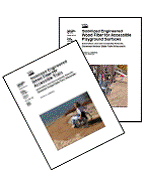
Board Research Leads to Improved Outdoor Surfacing April 11, 2007

 |
|
|---|---|
The Board's research project includes testing of treated wood chip surfacing at playgrounds and trails. |
Research sponsored by the Board is establishing ways to improve the performance of engineered wood fiber as a surfacing material for trails and playgrounds. Completed phases of a multi-year project involved tests of different treatments with the potential to make this wood chip material, a popular choice for outdoor surfaces, firmer and more stable for wheelchair traffic. Although final test phases are currently underway, the methods and materials deemed most effective by this research are being used to improve access at various locations, including at an outdoor performance center in the Washington, D.C. area.
Ground and floor surfaces must be firm, stable, and slip resistant in order to be accessible under the Board’s accessibility guidelines, including those issued under the Americans with Disabilities Act. While these criteria pose few challenges for indoor surfaces and paved surfaces, they generally preclude many loose materials, such as wood chips, used for outdoor trails and play surfaces unless they are properly treated and maintained. Consequently, the Board initiated research to examine ways to improve the firmness and stability of engineered wood fiber. The project is being conducted by the Department of Agriculture’s Forest Products Laboratory in Madison, Wisconsin.
Playgrounds pose a particular challenge to this effort since it is critical that their surfaces be soft enough to cushion falls and reduce injuries. The research project focused on the application of treated engineered wood fiber at play areas to determine whether the surface binders would pass industry tests for impact absorption, in addition to those for accessibility (specifically American Society for Testing and Materials (ASTM) measurement protocols for fall attenuation (ASTM F-1292) and wheelchair maneuverability (ASTM F-1951)).
Surfacing Improvement at Wolf Trap |
|
|
|
|
A bed is prepared for a layer of stone and geotextiles. |
|
|
|
|
Volunteers smooth in the top layer of engineered wood fiber which was premixed with a polyurethane binder. |
|
|
|
|
The completed route provides a firm and stable route through the seating area to wheelchair spaces. |
The project focused on determining which methods are most effective and reliable in improving accessibility and reducing maintenance of the material while preserving its effectiveness as a cushioning surface. In the first phase, researchers tested various combinations of materials and commercially available binding agents in a laboratory to determine successful candidates for long-term field testing. Subsequent field tests of top performing stabilizers, including polyurethane, latex, and silicone products, were conducted to assess how they held up over long-term exposure to the elements, including freeze-thaw cycles, rain, and heat. As part of this assessment, measurements for accessibility (surface firmness and stability) and impact absorption were routinely taken according to ASTM protocols. Two products that performed best in this phase were further tested in a local playground. They were also tested at trails in a Wisconsin state park.
The results indicate that a polyurethane product was most effective in providing an accessible surface that remained adequately impact-absorbent for use in play zones. The phases completed to date also established protocols for preparing and installing treated materials. The final phase of the project, currently underway, involves additional full-scale field assessments at an assortment of playgrounds and trails across the country, including test sites in Wisconsin, New York, Maryland, and California.
The results received to date from the project have been used to improve surfaces at various outdoor sites, including a complex of performance centers operated at Wolf Trap National Park in Vienna, Virginia. The installation was organized and conducted as an Eagle Scout project by Patrick Spitzer. Using products and installation methods established in the Board's research, Spitzer and his team of volunteers installed stabilized engineered wood fiber to improve the surface of routes and wheelchair seating spaces at an outdoor amphitheater operated by the Wolf Trap Foundation. The National Park Service covered the cost of materials, which were supplied by Zeager Brothers, Inc., a contributor of materials to the research project.
For further information on the Board’s research project, contact Bill Botten at botten@access-board.gov, (202) 272-0014 (v), or (202) 272-0082 (TTY). Reports from completed phases of the project are available:
